Feasibility Test of Business Projects of Petronas in Oil and Gas Sector in Malaysia
Added on 2023-06-15
63 Pages18207 Words155 Views
Running head: CASE STUDY
Case study
Student’s Name
University Name
Author’s Note
Case study
Student’s Name
University Name
Author’s Note
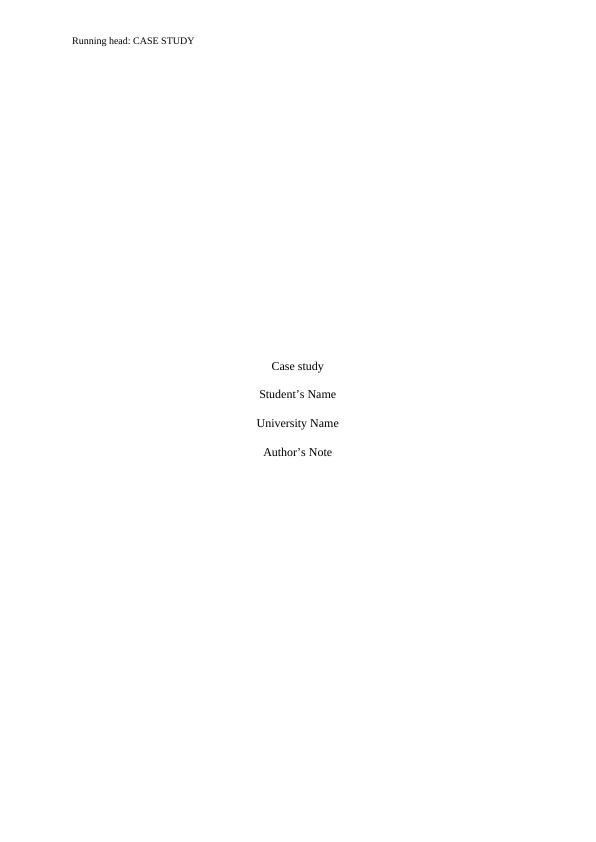
2CASE STUDY
Table of Contents
1.0 Introduction..........................................................................................................................3
1.1 Industry and Company Background.................................................................................3
1.1.1 The recent trends of Petronas.....................................................................................4
1.2 Business Issues/Opportunities..........................................................................................5
1.3 Research Purpose and Rationale......................................................................................6
1.4 Terms of Reference..........................................................................................................8
1.4.1 Research Questions....................................................................................................8
1.4.2 Research Objectives...................................................................................................8
2.0 Business Review..................................................................................................................8
2.1 The market size and trends...............................................................................................8
2.2 Customers by market segment..........................................................................................9
2.2.1 Buying behaviour.....................................................................................................10
2.3 Competitors....................................................................................................................11
2.4 Market share and sales projections.................................................................................12
2.4.1 Market Share............................................................................................................12
2.4.2 Sales Projections......................................................................................................12
2.5 Competitive Positioning.................................................................................................16
2.5.1 Porter’s Five Forces Analysis..................................................................................16
2.5.2 PESTEL analysis of Petronas..................................................................................18
2.6 Strategic Group Mapping...............................................................................................19
Table of Contents
1.0 Introduction..........................................................................................................................3
1.1 Industry and Company Background.................................................................................3
1.1.1 The recent trends of Petronas.....................................................................................4
1.2 Business Issues/Opportunities..........................................................................................5
1.3 Research Purpose and Rationale......................................................................................6
1.4 Terms of Reference..........................................................................................................8
1.4.1 Research Questions....................................................................................................8
1.4.2 Research Objectives...................................................................................................8
2.0 Business Review..................................................................................................................8
2.1 The market size and trends...............................................................................................8
2.2 Customers by market segment..........................................................................................9
2.2.1 Buying behaviour.....................................................................................................10
2.3 Competitors....................................................................................................................11
2.4 Market share and sales projections.................................................................................12
2.4.1 Market Share............................................................................................................12
2.4.2 Sales Projections......................................................................................................12
2.5 Competitive Positioning.................................................................................................16
2.5.1 Porter’s Five Forces Analysis..................................................................................16
2.5.2 PESTEL analysis of Petronas..................................................................................18
2.6 Strategic Group Mapping...............................................................................................19

3CASE STUDY
2.6.1 Product Diversity.....................................................................................................19
2.6.2 Geographic Coverage..............................................................................................19
2.6.3 Market Segments.....................................................................................................20
2.6.4 Distribution Channels..............................................................................................20
2.6.5 Extent of Brand Development.................................................................................20
2.6.6 Primary Marketing Analysis (marketing Mix)........................................................21
2.7 Customer Value propositions.........................................................................................22
3.0 Research Design.................................................................................................................23
3.1 Research Methods..........................................................................................................23
3.2 Data Collection Methods................................................................................................24
3.3 Ethical Considerations....................................................................................................25
4.0 Data Analysis.....................................................................................................................26
4.1 Case Findings Analysis..................................................................................................26
4.1.1 Case 1: impact of falling crude oil prices on other oil and gas products.................26
Case 2: impact of oil prices going down below US $30...................................................27
Case 3: Petronas posts 96% drop of profit for lower oil price..........................................29
4.2 Business Implications.....................................................................................................29
5.0 Conclusions and Recommendations..................................................................................30
5.1 Vision & Mission...........................................................................................................30
5.2 Objectives.......................................................................................................................30
5.3 Marketing Plan...............................................................................................................30
2.6.1 Product Diversity.....................................................................................................19
2.6.2 Geographic Coverage..............................................................................................19
2.6.3 Market Segments.....................................................................................................20
2.6.4 Distribution Channels..............................................................................................20
2.6.5 Extent of Brand Development.................................................................................20
2.6.6 Primary Marketing Analysis (marketing Mix)........................................................21
2.7 Customer Value propositions.........................................................................................22
3.0 Research Design.................................................................................................................23
3.1 Research Methods..........................................................................................................23
3.2 Data Collection Methods................................................................................................24
3.3 Ethical Considerations....................................................................................................25
4.0 Data Analysis.....................................................................................................................26
4.1 Case Findings Analysis..................................................................................................26
4.1.1 Case 1: impact of falling crude oil prices on other oil and gas products.................26
Case 2: impact of oil prices going down below US $30...................................................27
Case 3: Petronas posts 96% drop of profit for lower oil price..........................................29
4.2 Business Implications.....................................................................................................29
5.0 Conclusions and Recommendations..................................................................................30
5.1 Vision & Mission...........................................................................................................30
5.2 Objectives.......................................................................................................................30
5.3 Marketing Plan...............................................................................................................30
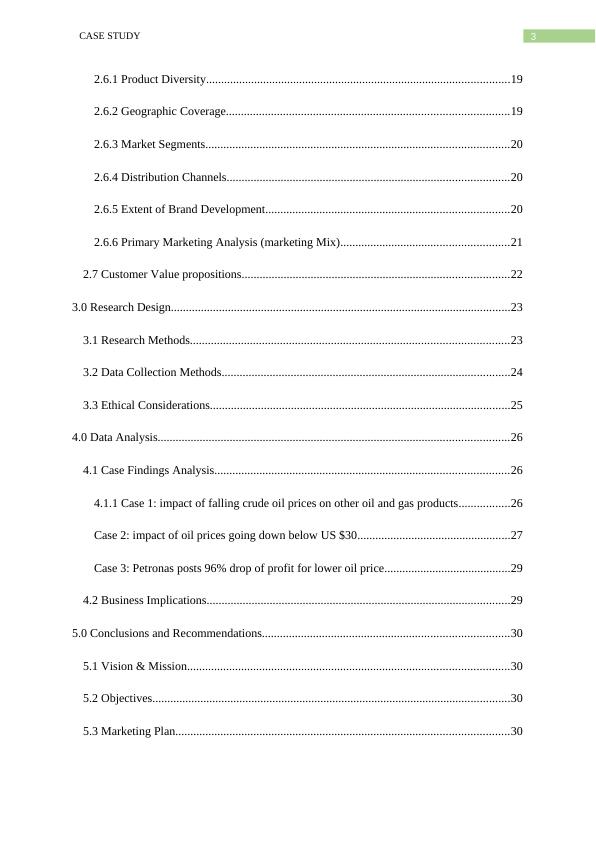
4CASE STUDY
5.3.1 Segmentation, Targeting & Positioning...................................................................30
5.3.2 Strategic Growth (Ansoff Matrix)...........................................................................31
5.4 Organizational/Operational Plan....................................................................................33
5.4.1 Organizational Structure..........................................................................................33
5.4.2 Human Capital Plan.................................................................................................34
5.4.3 Business Process/Value Chain.................................................................................35
5.5 Financial Plan / Business Metrics...................................................................................35
5.5.1 Financial statements.................................................................................................35
Startup Funds....................................................................................................................35
Profit and Loss Statement.................................................................................................38
Balance Sheet....................................................................................................................41
Break even........................................................................................................................44
Cash Flow statement.........................................................................................................45
5.5.2 Key Result Areas.....................................................................................................48
5.5.3 Assumptions, Explanation and Justification............................................................50
5.6 Implementation Schedule...............................................................................................54
5.7 Critical Success Factors..................................................................................................55
5.8 Risk Mitigation/Contingency Plan.................................................................................55
Reference List..........................................................................................................................57
5.3.1 Segmentation, Targeting & Positioning...................................................................30
5.3.2 Strategic Growth (Ansoff Matrix)...........................................................................31
5.4 Organizational/Operational Plan....................................................................................33
5.4.1 Organizational Structure..........................................................................................33
5.4.2 Human Capital Plan.................................................................................................34
5.4.3 Business Process/Value Chain.................................................................................35
5.5 Financial Plan / Business Metrics...................................................................................35
5.5.1 Financial statements.................................................................................................35
Startup Funds....................................................................................................................35
Profit and Loss Statement.................................................................................................38
Balance Sheet....................................................................................................................41
Break even........................................................................................................................44
Cash Flow statement.........................................................................................................45
5.5.2 Key Result Areas.....................................................................................................48
5.5.3 Assumptions, Explanation and Justification............................................................50
5.6 Implementation Schedule...............................................................................................54
5.7 Critical Success Factors..................................................................................................55
5.8 Risk Mitigation/Contingency Plan.................................................................................55
Reference List..........................................................................................................................57

5CASE STUDY
1.0 Introduction
1.1 Industry and Company Background
Petroliam Nasional Berhad is owned completely by the Malaysian Government and is
operated by the Minister of Finance (Inc.). Petronas Berhad is an acronym that stands for
Petroliam National Berhad. The company was established in the year 1974 and has been an
outcome of the national oil project in Malaysia. The organisation is owned, entirely by the
government. The corporation interested entirely with oil and gas resources in the country and
also shares the liability of developing as well as adding value to these National resources. The
company has steadily grown from being the primary regulator of the upstream sector in
Malaysia to become a fully integrated oil and gas producing domain. The organisation has
been ranked among the FORTUNE Global 500 and can be counted as one of the largest
corporations in the whole world. Since the investment into the national Oil and Gas sector,
the organisation has grown steadily to develop a place in the international oil and gas
business sharing its interests with 31 other countries (Othman 2018). About the time of
March 2005, the Petronas group comprised of 103 other subsidiaries who were wholly
owned, 19 August subsidiaries where Petronas had partial holding along with other 57
associated organisations. The Petronas Berhad Malaysia is a group that is constituting of all
these agent parties who are involved in various business activities related to the Oil and Gas
sector. The organisation and all its alliances and Associate or substituted agencies are
involved into a wide spectrum of Petroleum activities that incorporates upstream exploration
as well as production of Oil and Gas to down streaming oil refining, marketing as well as
distribution of the petroleum products, trading of Oil, gas transmission and setting up pipeline
network for the same operation, gas processing as well as liquefaction and other similar
activities (Quoquab et al. 2018). The Petronas group also carried out some allied activities
like marketing of liquefied natural gas, manufacturing of petrochemical products as well as
marketing along with shipping and automotive engineering. Lastly, the business group has
activities over property investment also.
In the course of its business operations, the organisational follows a discreet
operational strategy that incorporates the following:
Strategy of integration (103 wholly self-owned corporations, 19 partially owned
enterprises as well as 57 allied companies)
Value Generation
1.0 Introduction
1.1 Industry and Company Background
Petroliam Nasional Berhad is owned completely by the Malaysian Government and is
operated by the Minister of Finance (Inc.). Petronas Berhad is an acronym that stands for
Petroliam National Berhad. The company was established in the year 1974 and has been an
outcome of the national oil project in Malaysia. The organisation is owned, entirely by the
government. The corporation interested entirely with oil and gas resources in the country and
also shares the liability of developing as well as adding value to these National resources. The
company has steadily grown from being the primary regulator of the upstream sector in
Malaysia to become a fully integrated oil and gas producing domain. The organisation has
been ranked among the FORTUNE Global 500 and can be counted as one of the largest
corporations in the whole world. Since the investment into the national Oil and Gas sector,
the organisation has grown steadily to develop a place in the international oil and gas
business sharing its interests with 31 other countries (Othman 2018). About the time of
March 2005, the Petronas group comprised of 103 other subsidiaries who were wholly
owned, 19 August subsidiaries where Petronas had partial holding along with other 57
associated organisations. The Petronas Berhad Malaysia is a group that is constituting of all
these agent parties who are involved in various business activities related to the Oil and Gas
sector. The organisation and all its alliances and Associate or substituted agencies are
involved into a wide spectrum of Petroleum activities that incorporates upstream exploration
as well as production of Oil and Gas to down streaming oil refining, marketing as well as
distribution of the petroleum products, trading of Oil, gas transmission and setting up pipeline
network for the same operation, gas processing as well as liquefaction and other similar
activities (Quoquab et al. 2018). The Petronas group also carried out some allied activities
like marketing of liquefied natural gas, manufacturing of petrochemical products as well as
marketing along with shipping and automotive engineering. Lastly, the business group has
activities over property investment also.
In the course of its business operations, the organisational follows a discreet
operational strategy that incorporates the following:
Strategy of integration (103 wholly self-owned corporations, 19 partially owned
enterprises as well as 57 allied companies)
Value Generation
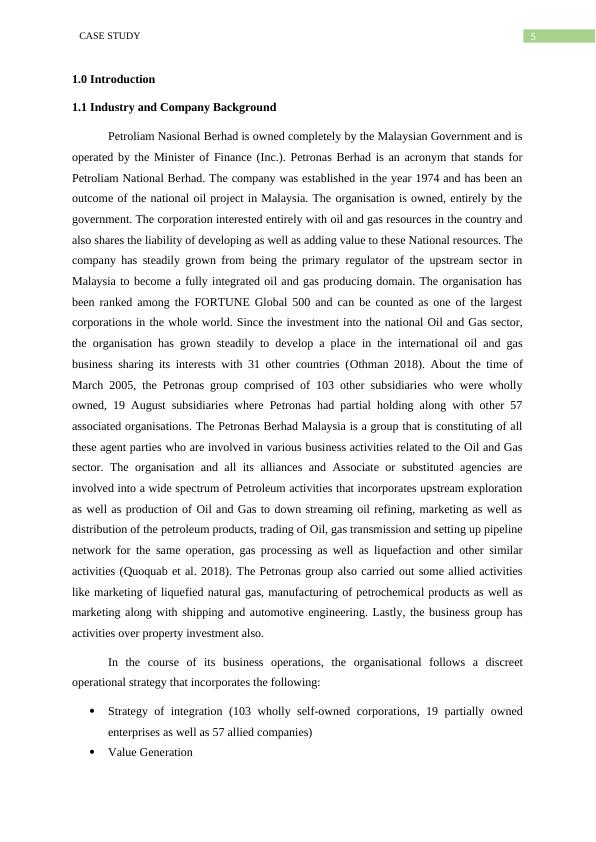
6CASE STUDY
Globalisation
The primary facets of business integration that helps in fostering globalisation for Petronas
Group, Malaysia are:
Exploration of new possibilities of oil mining and allied businesses and setting up
new business facilities and production outlets
Exploring further ventures under the domains like oil, gas, petrochemicals, logistics
and maritime
Setting up centres for research and technology
Working towards corporate sustainability in the home and foreign markets
There are several factors that has allowed Petronas, Berhad to retain their market
oligopoly. The most potential factor behind that is product standardisation and product
differentiation. Besides that, as Watanabe et al. (2018), reports, the organisation maintains
control of price. Price limitation is exercised through mutual interdependence, or it is
considerable with collision. However there are some negative implications of the market
oligopoly of Petronas also, for instance the organisation would face several obstacles in the
face of market entry in foreign markets. Parallely, factors of strength include product
differentiation strategy that is significantly employed by the company. Because of this, the
company enjoys advantages like non-price competition.
1.1.1 The recent trends of Petronas
Petronas has been able to gain proficiency in business development. This unique
skill added with their technical as well as operational competencies allows the group to get
increased acceptance as preferred strategic partner by the eminent transnational companies as
well as the congregation countries where the company conducts its business operations. The
organisation has gradually undergone a transformation from a local oil building company to
become a wholly integrated oil and gas corporation conducting business on a multinational
basis. Over the years, patroness has achieve significant milestones. In the year 2006 the
companies signed a concession agreement in Egypt delta resume with the North Sidi Kirit
Deep Offshore exploration block. Again, in the year 2007, Petronas was successful in
increasing its equity holding with the APA group (Omar, Dahalan and Yusoff 2016). This
helped the company to become the single largest shareholder in one of the largest Energy
Transmission and distribution agency of Australia. Followed by that in the year 2008 the
organisation went on to engage into a new PSC with Production Malaysia and ExxonMobil
Globalisation
The primary facets of business integration that helps in fostering globalisation for Petronas
Group, Malaysia are:
Exploration of new possibilities of oil mining and allied businesses and setting up
new business facilities and production outlets
Exploring further ventures under the domains like oil, gas, petrochemicals, logistics
and maritime
Setting up centres for research and technology
Working towards corporate sustainability in the home and foreign markets
There are several factors that has allowed Petronas, Berhad to retain their market
oligopoly. The most potential factor behind that is product standardisation and product
differentiation. Besides that, as Watanabe et al. (2018), reports, the organisation maintains
control of price. Price limitation is exercised through mutual interdependence, or it is
considerable with collision. However there are some negative implications of the market
oligopoly of Petronas also, for instance the organisation would face several obstacles in the
face of market entry in foreign markets. Parallely, factors of strength include product
differentiation strategy that is significantly employed by the company. Because of this, the
company enjoys advantages like non-price competition.
1.1.1 The recent trends of Petronas
Petronas has been able to gain proficiency in business development. This unique
skill added with their technical as well as operational competencies allows the group to get
increased acceptance as preferred strategic partner by the eminent transnational companies as
well as the congregation countries where the company conducts its business operations. The
organisation has gradually undergone a transformation from a local oil building company to
become a wholly integrated oil and gas corporation conducting business on a multinational
basis. Over the years, patroness has achieve significant milestones. In the year 2006 the
companies signed a concession agreement in Egypt delta resume with the North Sidi Kirit
Deep Offshore exploration block. Again, in the year 2007, Petronas was successful in
increasing its equity holding with the APA group (Omar, Dahalan and Yusoff 2016). This
helped the company to become the single largest shareholder in one of the largest Energy
Transmission and distribution agency of Australia. Followed by that in the year 2008 the
organisation went on to engage into a new PSC with Production Malaysia and ExxonMobil
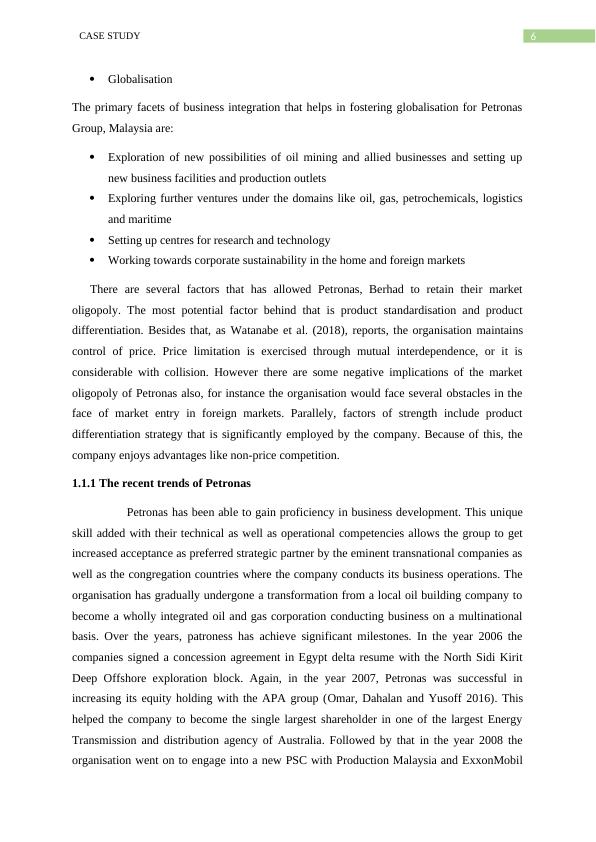
7CASE STUDY
Exploration. The strategic partnership between the two Organisations allowed the PSC
partners to conduct upstream participation in the seven oil fields offshore Peninsular
Malaysia. This is how the organisation have been successful in gathering foreign direct
investment in to the country also. As reported by Lim and Goh (2019), the organisation also
serves the national defence by delivering biodiesel to the Ministry of Defence as well as the
Dewan Bandaraya Kuala Lumpur (DBKL).
1.2 Business Issues/Opportunities
The direct impact of the oil price crash will significantly impact the Petronas Berhad Group
since national economic progress is bound to cast its impact on the 100% government owned
organisations.
Reportedly, organisations like BP, Statoil Norway, Shell as well as Woodside
Petroleum of Australia have subsided about US$200 billion worth capex on their projects
undertaken in Malaysia, owing to the slumping prices of oil in the country. Another major
ally of Petronas, Technip from France, is also expected to reduce the strength of their work
force in Malaysia by 20%. The working lot that would be terminated might include locals as
well as expatriates who are working on contract as well as full time basis (Kardooni, Yusoff
and Kari 2016). Petronas had strategic partnership in all these projects and that the revenue
stream of the organisation is also going to be severely affected. However, the fact that makes
the situation worse for Petronas is that in the midst of this economic crisis in the oil and gas
sector, the company has taken up two massive projects which requires billions of investment.
The first project is located at Pengerang as well as Johor (Badeeb, Lean and Smyth 2016).
This is the 60 billion Malaysian Ringgit worth refinery and Petrochemicals Integrated
Development project. The second project is an overseas LNG project to take place in Canada.
This Petronas led Pacific North West LNG project is worth 137 billion Malaysian Ringgit.
As an impact of launching the project immediately before the encroachment of the oil
price crisis in the country, the organisation could not take the advantage of working in a
comparatively low cost environment. The organisation will have to carry on with this long
drawn project for years now. However, they would be able to reap financial advantage only if
the oil and gas prices of the country rise back to the position of the yesteryears.
As indicated by Zakaria, Nawawi and Salin (2016), the direct impact of the oil price
crash will significantly impact the Petronas Berhad Group since national economic progress
is bound to cast its impact on the 100% government owned organisations.
Exploration. The strategic partnership between the two Organisations allowed the PSC
partners to conduct upstream participation in the seven oil fields offshore Peninsular
Malaysia. This is how the organisation have been successful in gathering foreign direct
investment in to the country also. As reported by Lim and Goh (2019), the organisation also
serves the national defence by delivering biodiesel to the Ministry of Defence as well as the
Dewan Bandaraya Kuala Lumpur (DBKL).
1.2 Business Issues/Opportunities
The direct impact of the oil price crash will significantly impact the Petronas Berhad Group
since national economic progress is bound to cast its impact on the 100% government owned
organisations.
Reportedly, organisations like BP, Statoil Norway, Shell as well as Woodside
Petroleum of Australia have subsided about US$200 billion worth capex on their projects
undertaken in Malaysia, owing to the slumping prices of oil in the country. Another major
ally of Petronas, Technip from France, is also expected to reduce the strength of their work
force in Malaysia by 20%. The working lot that would be terminated might include locals as
well as expatriates who are working on contract as well as full time basis (Kardooni, Yusoff
and Kari 2016). Petronas had strategic partnership in all these projects and that the revenue
stream of the organisation is also going to be severely affected. However, the fact that makes
the situation worse for Petronas is that in the midst of this economic crisis in the oil and gas
sector, the company has taken up two massive projects which requires billions of investment.
The first project is located at Pengerang as well as Johor (Badeeb, Lean and Smyth 2016).
This is the 60 billion Malaysian Ringgit worth refinery and Petrochemicals Integrated
Development project. The second project is an overseas LNG project to take place in Canada.
This Petronas led Pacific North West LNG project is worth 137 billion Malaysian Ringgit.
As an impact of launching the project immediately before the encroachment of the oil
price crisis in the country, the organisation could not take the advantage of working in a
comparatively low cost environment. The organisation will have to carry on with this long
drawn project for years now. However, they would be able to reap financial advantage only if
the oil and gas prices of the country rise back to the position of the yesteryears.
As indicated by Zakaria, Nawawi and Salin (2016), the direct impact of the oil price
crash will significantly impact the Petronas Berhad Group since national economic progress
is bound to cast its impact on the 100% government owned organisations.

8CASE STUDY
Reportedly, organisations like BP, Statoil Norway, Shell as well as Woodside
Petroleum of Australia have subsided about US$200 billion worth capex on their projects
undertaken in Malaysia, owing to the slumping prices of oil in the country. Another major
ally of Petronas, Technip from France, is also expected to reduce the strength of their work
force in Malaysia by 20% (Abdeshahian et al. 2016). The working lot that would be
terminated might include locals as well as expatriates who are working on contract as well as
full time basis. Petronas had strategic partnership in all these projects and that the revenue
stream of the organisation is also going to be severely affected. However, the fact that makes
the situation worse for Petronas is that in the midst of this economic crisis in the oil and gas
sector, the company has taken up two massive projects which requires billions of investment.
The first project is located at Pengerang as well as Johor. This is the 60 billion Malaysian
Ringgit worth refinery and Petrochemicals Integrated Development project (Bujang, Bern
and Brumm 2016). The second project is an overseas LNG project to take place in Canada.
This Petronas led Pacific North West LNG project is worth 137 billion Malaysian Ringgit.
As an impact of launching the project immediately before the encroachment of the oil
price crisis in the country, the organisation could not take the advantage of working in a
comparatively low cost environment. The organisation will have to carry on with this long
drawn project for years now (Sabir and Isha 2016). However, they would be able to reap
financial advantage only if the oil and gas prices of the country rise back to the position of the
yesteryears.
1.3 Research Purpose and Rationale
The main purpose behind development of this business plan is to test the feasibility of
the business projects of Petronas against the industrial backdrop of the Oil and Gas sector in
Malaysia. This feasibility test will also allow an analysis of the competitive rivalry that
Petronas needs to face from the existing market peers. Te preparation of this business project
would also help in the development of a conception about the success proximity of the
current implemented business strategies of the organisation in both local as well as
international markets. A detailed financial analysis of the organisation have also been
conducted in the business project with an eye to highlight how the company have been able to
tackle the market downturn that plagued many of the market activities of Petronas in
Malaysia. Lastly, this business plan also helps to analyse how the organisation have been able
Reportedly, organisations like BP, Statoil Norway, Shell as well as Woodside
Petroleum of Australia have subsided about US$200 billion worth capex on their projects
undertaken in Malaysia, owing to the slumping prices of oil in the country. Another major
ally of Petronas, Technip from France, is also expected to reduce the strength of their work
force in Malaysia by 20% (Abdeshahian et al. 2016). The working lot that would be
terminated might include locals as well as expatriates who are working on contract as well as
full time basis. Petronas had strategic partnership in all these projects and that the revenue
stream of the organisation is also going to be severely affected. However, the fact that makes
the situation worse for Petronas is that in the midst of this economic crisis in the oil and gas
sector, the company has taken up two massive projects which requires billions of investment.
The first project is located at Pengerang as well as Johor. This is the 60 billion Malaysian
Ringgit worth refinery and Petrochemicals Integrated Development project (Bujang, Bern
and Brumm 2016). The second project is an overseas LNG project to take place in Canada.
This Petronas led Pacific North West LNG project is worth 137 billion Malaysian Ringgit.
As an impact of launching the project immediately before the encroachment of the oil
price crisis in the country, the organisation could not take the advantage of working in a
comparatively low cost environment. The organisation will have to carry on with this long
drawn project for years now (Sabir and Isha 2016). However, they would be able to reap
financial advantage only if the oil and gas prices of the country rise back to the position of the
yesteryears.
1.3 Research Purpose and Rationale
The main purpose behind development of this business plan is to test the feasibility of
the business projects of Petronas against the industrial backdrop of the Oil and Gas sector in
Malaysia. This feasibility test will also allow an analysis of the competitive rivalry that
Petronas needs to face from the existing market peers. Te preparation of this business project
would also help in the development of a conception about the success proximity of the
current implemented business strategies of the organisation in both local as well as
international markets. A detailed financial analysis of the organisation have also been
conducted in the business project with an eye to highlight how the company have been able to
tackle the market downturn that plagued many of the market activities of Petronas in
Malaysia. Lastly, this business plan also helps to analyse how the organisation have been able
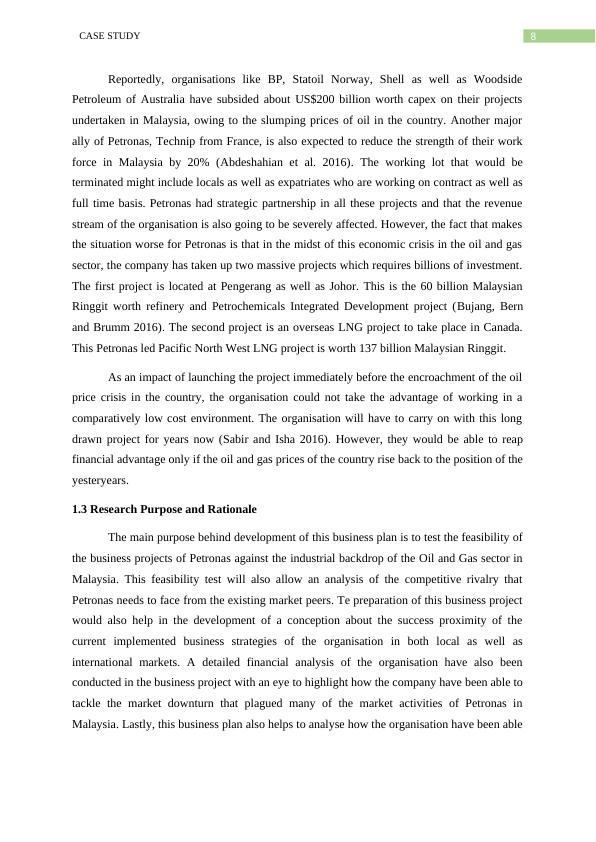
End of preview
Want to access all the pages? Upload your documents or become a member.
Related Documents
Report on Importance of Leading Innovation and Change Interventionslg...
|34
|8044
|123
Case Study on UK e-Tourism Industry Name of Student: University Namelg...
|65
|10458
|497
Health, Safety and Environmental Plans for Royal Dutch Shell on Oil Productionlg...
|82
|20355
|357
A Business Development Plan to Enhance Business Performance: A Case Study of AirAsia Berhad in Malaysialg...
|44
|15084
|3
XXX in China: Marketing Strategies for Expansionlg...
|68
|16736
|25
The Effects of Performance Appraisal System on Employees’ Performance in the Public Service of Jamaica – A Case Study of the Jamaica Constabulary Forcelg...
|70
|22885
|249